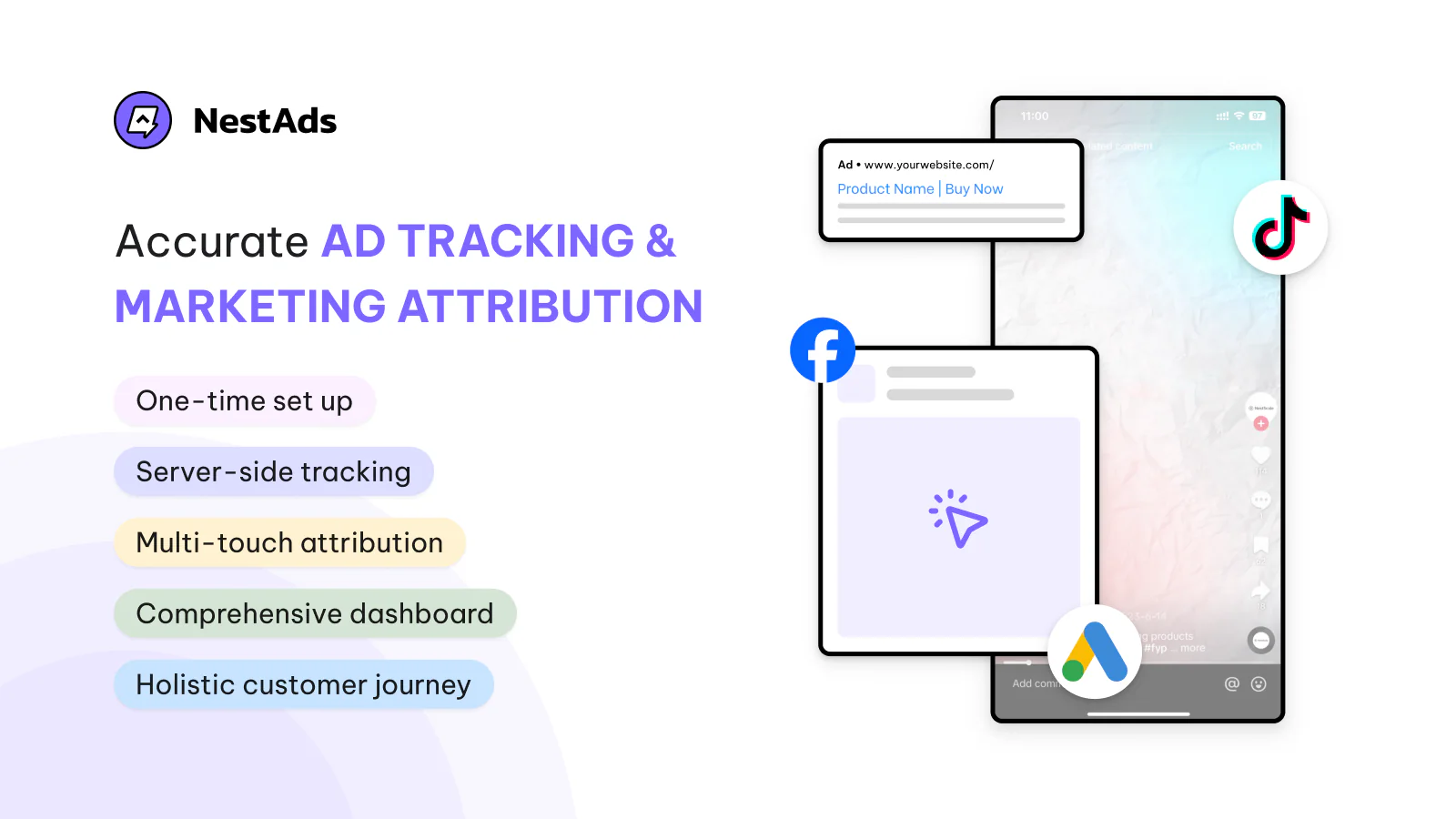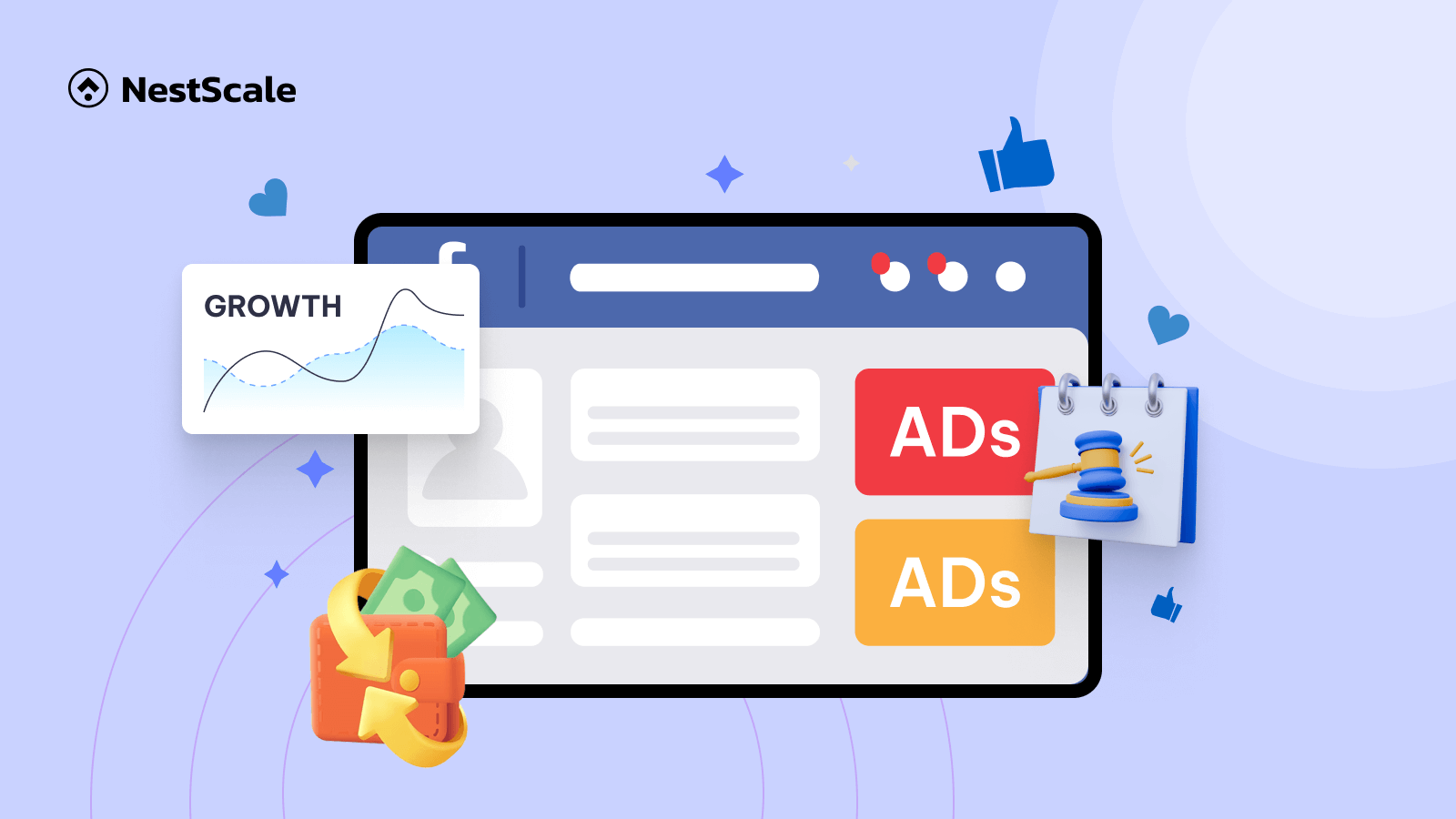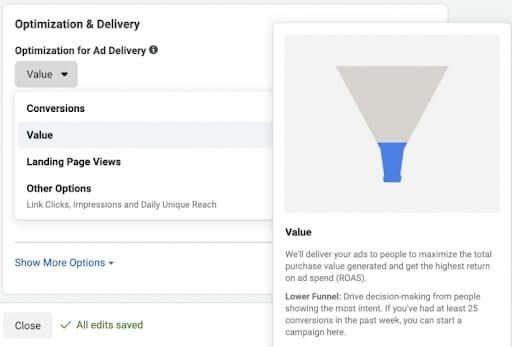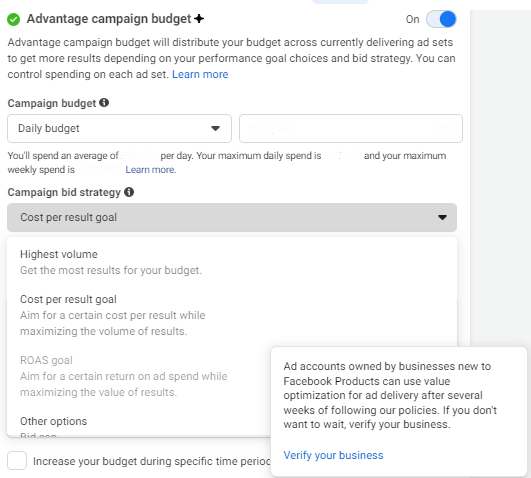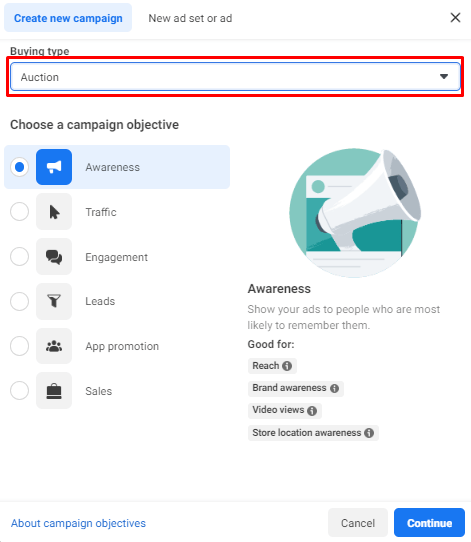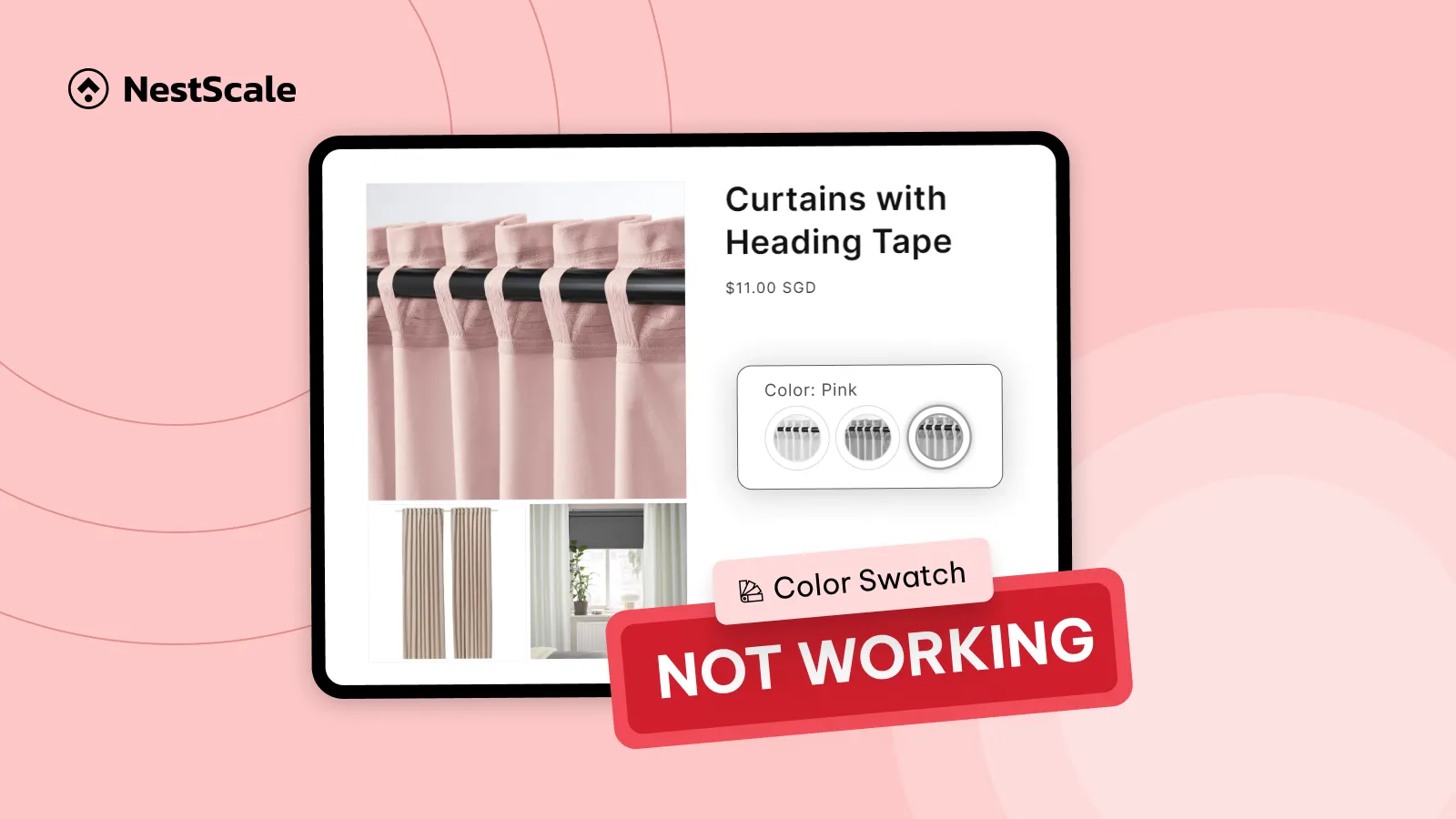For e-commerce merchants, leveraging Facebook Ads effectively can make a significant difference in your business’s growth and profitability. And one of the key components of a successful Facebook Ads campaign is understanding and mastering the various bidding strategies available. This blog will guide you through the types of bidding strategies available for Facebook ads and how to choose the right one for your business. So, without any further ado, let’s dive in!
Why Facebook Ads bidding strategies matter?
Facebook Ads bidding is more than just setting a budget; it’s about strategically managing your ad spend to maximize results. Bidding strategies dictate how your ads are delivered to your target audience, influencing your campaign’s overall performance and ROI. Effective bidding strategies can help you:
- Optimize ad spend: Ensure you’re paying the right amount for the desired actions, be it clicks, conversions, or impressions.
- Improve ad performance: Properly managed bids can enhance ad delivery and relevance, leading to better engagement and conversion rates.
- Maximize ROI: By aligning your bids with your business goals, you can achieve a higher return on ad spend (ROAS).
Types of Facebook ads bidding strategies
Facebook offers various bidding strategies to cater to different campaign goals and budgets. Understanding these options can help you choose the right one for your business. Based on the update from Meta Ads Manager, here are the 5 currently applied bidding strategies of Facebook Ads, divided into 3 main types:
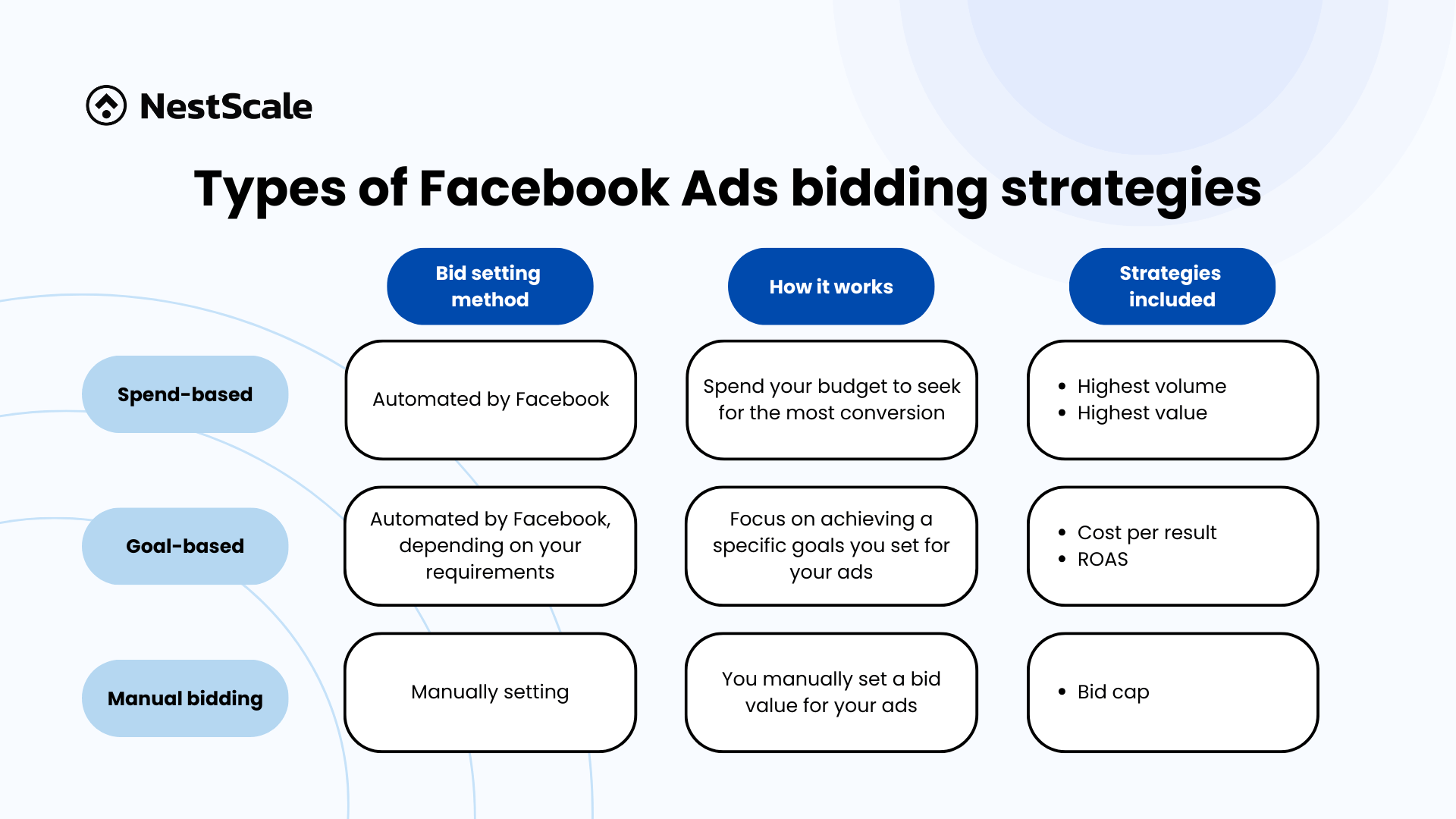
Spend-based bidding strategies
Spend-based bidding is straightforward and typically the default when you select a campaign objective on Facebook. The essence of this strategy is to focus on spending your entire Facebook ads budget while achieving the maximum possible results or value. Let’s break down the two main types of spend-based bidding strategies:
Highest volume (Formerly lowest cost)
The highest volume is one of the most used strategies when using Facebook ads, as it’s straightforward and beginner-friendly, requiring minimal initial configuration.
How it works:
The highest volume strategy is designed to maximize the number of conversions you can achieve within your budget. When you choose this strategy, you set the maximum budget you want to spend on your Facebook ads. Facebook’s algorithms will then adjust its bids to prioritize acquiring as many conversions as possible within that budget.
Best suitable for:
Highest volume is the go-to strategy if you aim to attract as many people as possible. It’s most effective when:
- Aiming for non-revenue goals: Such as awareness, engagement, or traffic.
- Linking ads to a single-product landing page: This makes it easier to predict the average conversion value.
However, the focus on the volume of conversions might result in lower-quality conversions, especially if the campaign’s end goal isn’t directly tied to your revenue.
| Pros | Cons |
|---|---|
| – Easy to setup – Ideal for maximizing the volume of non-revenue goals |
– Might result in lower-quality conversions – Provides less control over individual costs, which can lead to higher expenses for each conversion |
Highest value
The highest value bidding strategy, on the other hand, focuses on achieving higher-quality conversions rather than maximizing the number of conversions.
How does it work
Similar to the highest volume bidding strategy, you start by setting the maximum budget you want to spend on your Facebook ads. Facebook will then adjust its bids accordingly to acquire the desired conversion actions.
However, instead of just aiming for as many conversions as possible, Facebook’s algorithm predicts which audience members are likely to generate a higher ROAS based on past purchase history and engagement data. Essentially, Facebook will bid higher on users who are likely to spend more at your store.
Best suitable for:
While Facebook claims that this strategy can drive more revenue to your store, the end result is still measured by the number of conversions, not the revenue itself. Therefore, we recommend using this strategy in the following scenarios:
- Aiming to acquire more data: This strategy is useful for gathering detailed insights for future campaigns.
- Campaign goals focused on lead generation: Ideal for campaigns where the objective is to acquire high-quality leads rather than immediate sales.
| Pros | Cons |
|---|---|
| – Getting more qualified data for your store | – Require the previous setup for your store |
Goal-based bidding strategies
Goal-based bidding strategies focus on achieving specific cost or value targets rather than just spending a set budget. Unlike spend-based strategies where the aim is to utilize the full budget, goal-based strategies optimize for CPA or ROAS. Here’s a deeper look at the main types of goal-based bidding strategies:
Cost per result goal (Formerly cost cap)
The cost per result strategy is designed to keep your acquisition costs around a specified amount, regardless of market fluctuations.
How it works:
When you choose this strategy, you set a target CPA that you aim to maintain throughout your campaign. Facebook then optimizes your bids to reach this target cost, focusing on acquiring conversions at or below your specified CPA.
During the initial learning phase, you might see your ad spend fluctuate significantly—sometimes lower or higher than your desired CPA. This happens because Facebook’s algorithm adjusts bids to find the optimal cost per acquisition. However, over time, the CPA will stabilize and get closer to your target.
For the cost per result bidding strategy, it is recommended to set a realistic CPA. This allows Facebook more flexibility to explore and reach the right customers. Moreover, if you set a CPA that’s too low, there is a high chance that your budget won’t be spent and fall short from your goals. Starting with spend-based strategies can help you gather market insights before transitioning to this strategy.
Best suitable for:
- More control over ad spending: Ideal if you want precise control over your advertising costs.
- Calculating average order value: Useful for campaigns where you need to calculate and manage your average order value.
- Stable conversion value: Best for campaigns where the conversion value is relatively stable.
| Pros | Cons |
|---|---|
| – Helps maintain stable and predictable advertising costs. – More targeted reach |
– Ad spend might fluctuate during the learning phase. – You may face bid limitations if you set a CPA that is too low. |
ROAS goals (Formerly minimum ROAS)
The ROAS goals strategy is similar to the cost per result goals in its basic functionality. However, instead of focusing on CPA, you set a target ROAS for your campaign. A little note if you want to use this strategy, is that you must either verify your business or run ads for a few weeks first before getting started.
How it works:
When you choose this strategy, you set a minimum ROAS target that you want to achieve for your campaign. Facebook then prioritizes bids that are likely to deliver higher conversion values, ensuring that your ad spend is aligned with revenue generation. This strategy works best when you have a clear understanding of your revenue per conversion and can accurately track these values.
Like the cost per result goals, your ads will go through a learning phase where spending can fluctuate significantly. This fluctuation occurs as Facebook adjusts your bids to achieve the closest possible results to your target ROAS.
Best suitable for:
ROAS goals are best suited for:
- Revenue-driven goals: Ideal if you aim to achieve higher revenue for your store and have direct revenue-driven objectives.
- Clear ROAS targets: Effective when you have a clear target ROAS in mind for your Facebook Ads campaign.
| Pros | Cons |
|---|---|
| – Focus on achieving profit for your store – Help you optimize your budget and your revenue |
– Require ongoing adjustment – Require deep understanding of your store’s ROAS |
Manual bidding strategies
While Facebook offers powerful automatic bidding strategies, some advertisers prefer to have more control over their bids. This is where manual bidding strategies come into play. They provide the flexibility to set specific bid amounts rather than allowing Facebook to determine the bid dynamically. Here’s a deeper dive into the manual bidding strategy known as bid cap:
Bid cap
The Bid Cap strategy allows you to set a maximum bid for each auction, giving you complete control over how much you’re willing to pay per action. This strategy is particularly useful for advertisers who have a solid understanding of their predicted conversion rates and can calculate the optimal bid amounts to achieve their campaign goals.
How it works:
Instead of allowing Facebook to dynamically adjust your bid based on your cost or value goals, you specify the maximum amount you are willing to pay for a given action. This fixed bid approach helps you maintain strict control over your advertising costs and ensures that you do not overpay in competitive auctions.
Best suitable for:
The Bid cap strategy is best suited for scenarios where:
- Maximal budget control: You want the most control over your advertising budget.
- Low price point products: You’re running ads for products with a low price point and want to ensure that your sales remain profitable.
- Tightly controlled conversion costs: You need your conversion costs to be tightly controlled to maintain profitability.
| Pros | Cons |
|---|---|
| – Have greater control over your cost – Helps manage and predict advertising costs effectively |
– Requires more expertise and experience – Need constant monitor |
How to set up your Facebook ads bidding strategies
Facebook allows you to set up your bidding strategy at the campaign level. To get started, open your Meta Ads Manager and create a new campaign by clicking on Create.
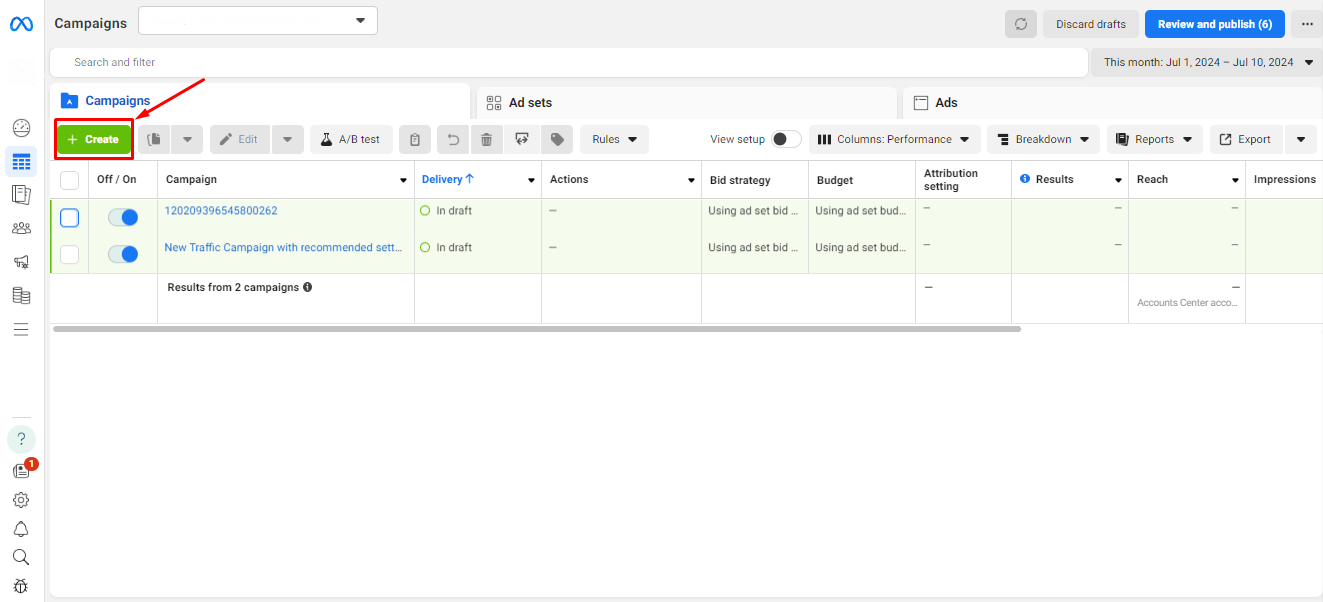
Choose a campaign objective that aligns with your goals. Keep in mind that the campaign objective you select will influence the ad settings and available bidding strategies. Additionally, remember to select Auction as the buying type.
In your campaign setup, turn on the toggle in the Advantage Campaign Budget section. Once this toggle is activated, you can adjust the bidding strategy you want to use.
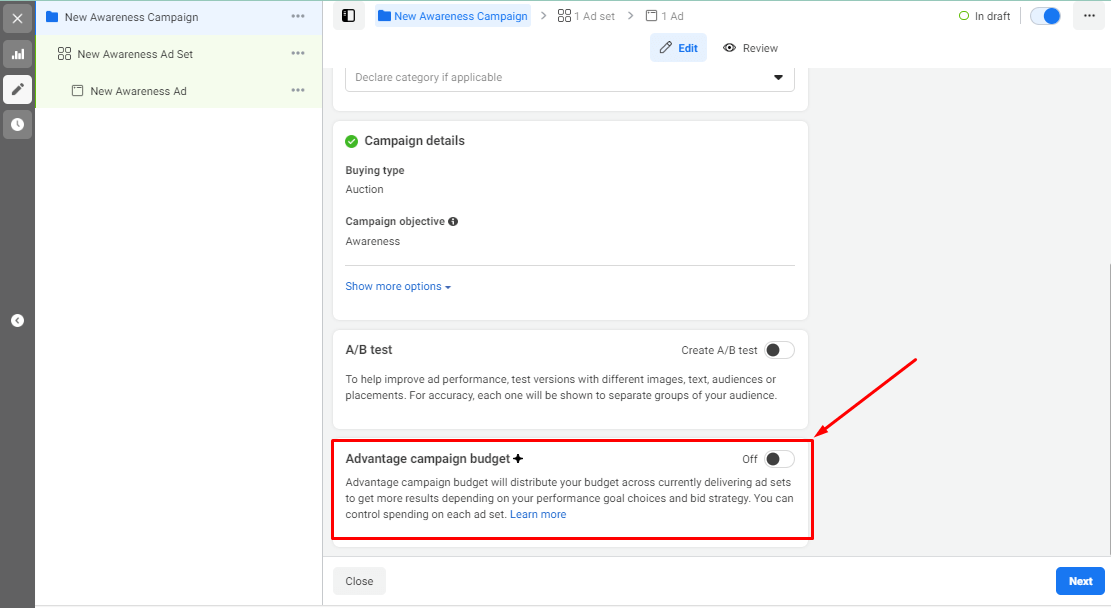
In the campaign bid strategy section, click on Edit. Then, choose the strategy that you think is most suitable for your goals.
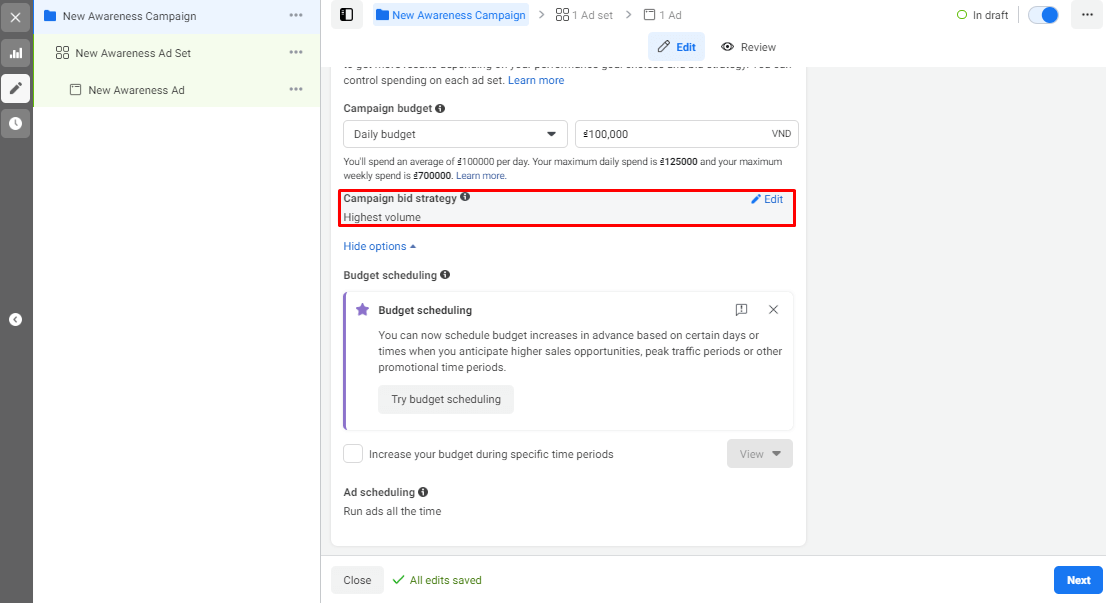
If you choose the Bid Cap as your bidding strategy, you’ll need to take an additional step in your ad set. Set your bid control, and you’re done.
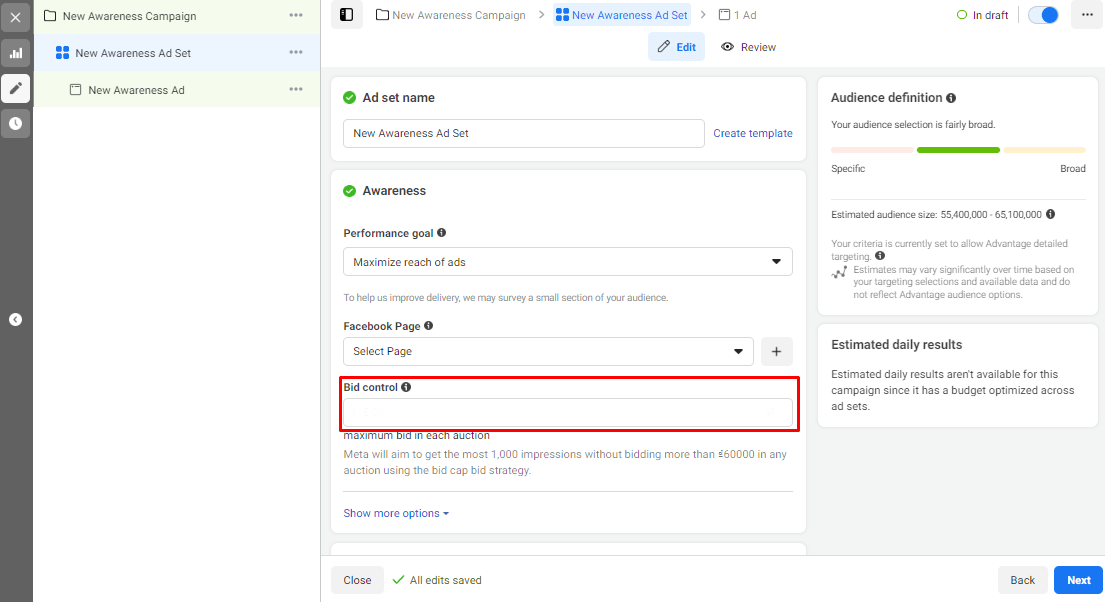
How to choose the right bid strategy for your Facebook ads
Selecting the right bidding strategy is crucial for maximizing the effectiveness of your Facebook ads. To make an informed decision, consider the following key questions and factors:
The level of control you want for your ads cost
If you’re new to Facebook ads and want to gather as much data as possible without strict cost control, automatic bidding strategies like highest volume can be a good starting point. However, if profitability is your primary concern and you need to closely monitor your costs, manual bidding strategies like bid cap or goal-based strategies such as cost per result goal and ROAS goal provide more control.
From our perspective, we recommend goal-based bidding strategies for e-commerce businesses. These align with most e-commerce goals, which are revenue and profit. Goal-based strategies let you set specific targets for your advertising while still allowing Facebook’s algorithm to optimize tactics. These strategies help ensure that you stay within your desired CPA or achieve a specific ROAS.
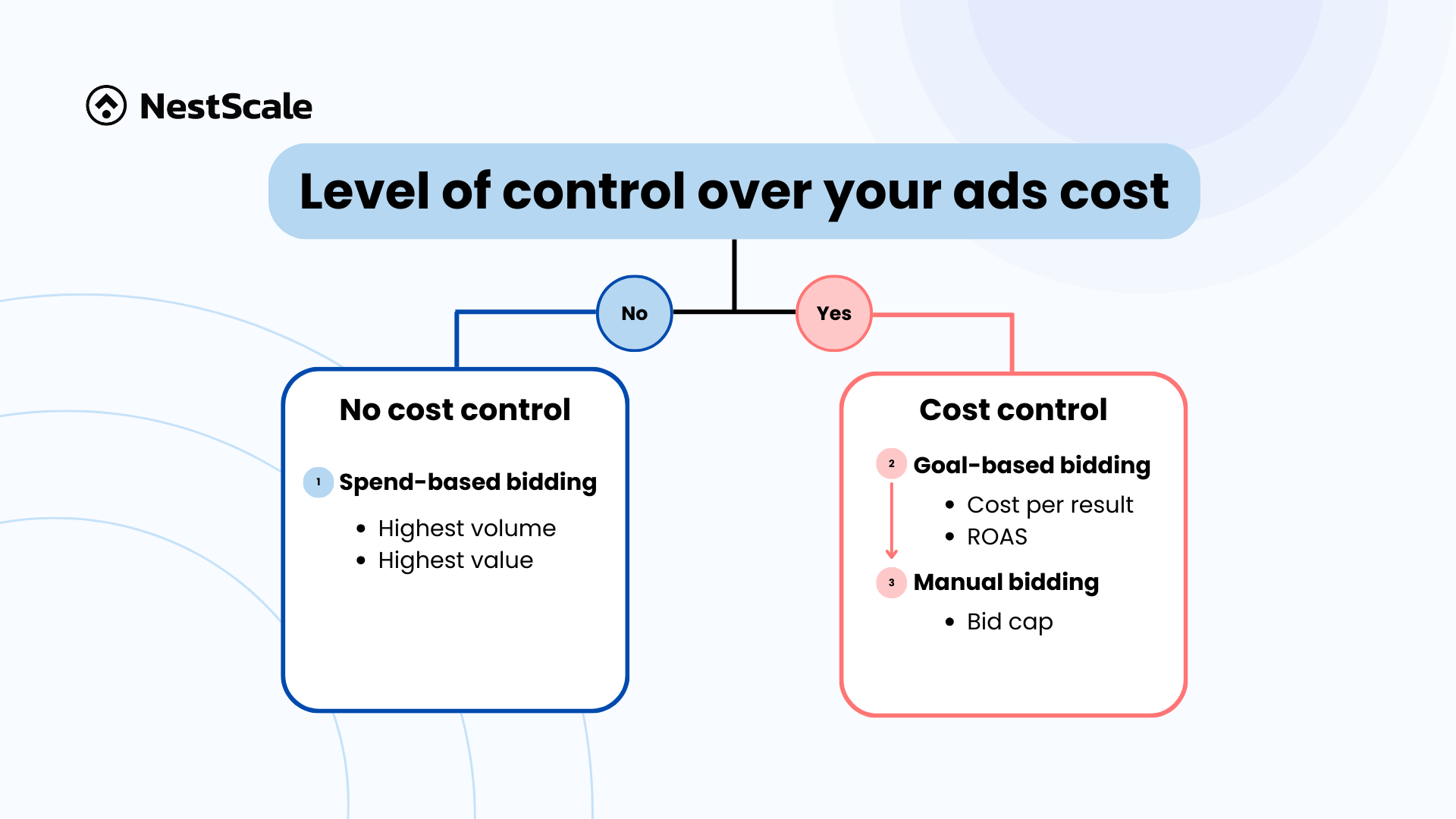
Your skill level
If this is your first time running Facebook ads, starting with simpler, automatic bidding strategies is advisable. These require less historical data and are easier to manage. As you become more experienced and gather more data, you can experiment with more complex strategies. If you have a good understanding of your conversion rates and historical data, you can leverage more advanced strategies like bid cap or ROAS goals to optimize your ad spend and achieve specific financial targets.
Your campaign objective
For objectives like page likes, post engagement, or video views, you may not want to spend a lot. Spend-based strategies like highest volume are suitable as they maximize reach and engagement. For purchase conversions or lead generation, where the goal is revenue-driven, goal-based strategies like cost per result or ROAS are more appropriate. These strategies focus on maximizing the value of each conversion.
Choose your winning bidding strategy with data-driven insights
Wanna get a grasp on your store performance to decide your bidding strategy? This is where NestAds steps in as a game-changer for businesses looking to optimize their Facebook Ads bidding strategies. NestAds is designed to streamline your marketing efforts across multiple platforms. By centralizing data and providing detailed insights into critical metrics like ROAS, CPA, and conversion rates, NestAds empowers merchants to make informed decisions and refine their bidding strategies.
If you’re ready to elevate your advertising strategy and achieve remarkable results, explore what NestAds can offer. Click here to dive into a world where data-driven decisions lead to optimized ad performance and significant business growth. Unlock the full potential of your Facebook Ads with NestAds today.
